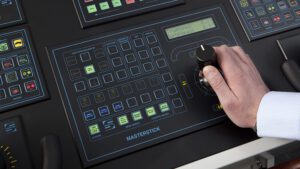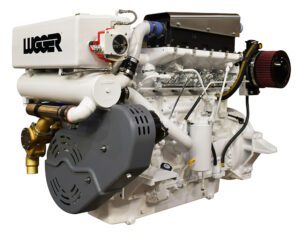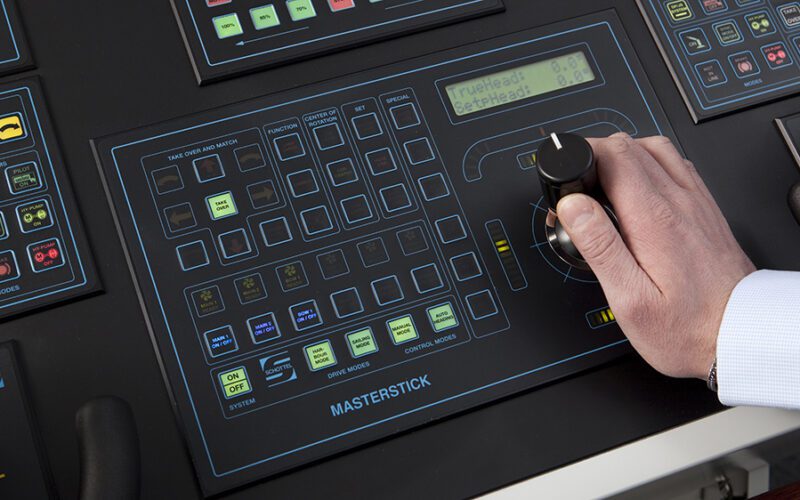
It’s common to think “green” when discussing new technologies, including in the marine fuel and propulsion arena.
And based on discussions with developers of marine propulsion systems, the green movement is coming – it’s just not quite there yet, and the technology won’t replace standard diesel engines anytime soon.
Dave Hughes, a U.S. marine sales manager for Scania, the large Swedish manufacturer, is excited about new green technologies. However, he told Pacific Maritime, he believes diesel power and other traditional propulsion systems will still be in operation and in demand for some time.
“There’s been a lot of research and development on alternative fuels, methanol, ethanol hydrogen, etc. And those I believe do have a future, but I believe that future for those applications or installations is quite a ways off,” Hughes said.
Hughes has seen numerous diesel electric propulsion systems, hybrid or full electric, come to market and begin operating in large, all-electric passenger vessels in Europe. The trend is certainly going that way.
“Probably the downside that’s consistent across all these emerging technologies is infrastructure. You start talking hybrid or anything with a battery, you have to have shoreside power to plug it in, and so on,” Hughes said.
‘Better Mouse Trap’
“Our support structure, it just isn’t quite there yet,” Hughes added. “So, when it comes to technologies, I think we’re all kind of in the infant stage, if you will, and we’re all trying to figure out the best mouse trap, right?”
Scania has been working on an inline electric motor/generator propulsion solution, a propulsion package designed and developed to be mated to the Scotty engines. It’s an inline configuration that bolts on directly, eliminating the need for an adapter. Scania provides all the subsidiary components.
“It’s a one-stop-shop, single-source solution, if you will, and with that we actually have the ability to program the different drive functions in the propulsion system,” Hughes said. “So, it would operate as one would think of driving a Prius, right?”
“Based off of the user profile setup, we can dictate an electric option or diesel option or a combination of both,” he explained. “We can monitor battery state to facilitate the unit to be turned into a generator to recharge batteries on board.”
The technology in the Scania marine brand he mentioned was derived from the company’s highway, truck and bus segment in Europe. A factory there has been developing hybrid electric buses and trucks in Europe with the first ones already hitting the market.
“When you think about larger hybrid or electric propulsion systems, they’re running primarily diesel electric, you know, or full electric, and both of those have kind of some challenges that go along with them,” Hughes said.
That is why he advises people not to dismiss the appeal and usefulness of diesel propulsion right now.
“We don’t foresee the diesel engine going away anytime soon, primarily because a hybrid propulsion system doesn’t make sense in all applications – there are certain situations where hybrid or electric just doesn’t make sense; the technology isn’t there to date,” Hughes said.
Growing Market
Paul Leask, executive vice president with Seattle-based manufacturer Northern Lights, has seen a market grow for options around reducing emissions, and he also sees a mix of interest in more efficient propulsion and propulsion that makes the best sense for operators.
“They’re looking for options for things that help reduce their emissions profile. Hybrid is one of the options that’s being looked at, and there are other versions of hybrid out there,” Leask told Pacific Maritime.
“Everybody thinks about hybrid as being electric only, and that’s not necessarily true,” he continued. “There are applications where vessels sit and idle at long periods of time, and when you run one of these giant engines at an idle, it’s not at its most efficient or cleanest operating range, so things like electric-hybrid allow you the ability to shut off the main engine so that it’s not polluting.”
Other options include transmissions with the availability to shut off the main engine and take in power from a smaller generator set or a smaller engine that can help keep propellers spinning and running in a more optimum load range, making the vessel cleaner and more efficient.
“I think there’s a lot of activity in these kind of markets, we don’t know which one’s going to come out on top, but a lot of people are looking for things like this, depending on the application,” Leask said.
Karl Hanson, the West Coast regional sales manager for Schottel Inc., a manufacturer of propulsion and steering systems for ships and offshore applications, said he’s seeing a big push for greener operations while vessels continue to need larger diesel engines for longer voyages.
“The idea of going to hybrid on vessels is finding a better business case for a lot of vessels that have runs that are shorter to medium, but for vessels that have long runs, hybrid technology is really to get into port and get out of a port,” he said. “That’s about as useful as it gets.”
Introducing Efficiencies
Hanson said many operators are introducing more green efficiencies aboard vessels, including getting vessel operations in “hybrid states” in which generators are warmed up before being turned on, or oils are preheated to near engine temperatures before start up.
“There are some basic things that you can do that may be a little more responsible and in keeping with the idea of being green,” Hanson said.
One fuel consumption reduction development that Schottel has been selling is called MasterStick, a joystick system that can control up to six propulsion units at once. The thrust and the alignment of the propulsion units are controlled and distributed by computer, optimizing translational and rotational movements required for maneuvering.
“You can turn off one engine and link up the two propellers to one engine and run it at its most efficient level, which is generally 70% to 80% loads, and so that becomes a really great benefit of going greener without having to throw a bunch of batteries on your vessels,” Hanson explained.
To deal with seas and winds that push vessels off course, operators traditionally use propulsion units on the back of the vessel to hold steady, often forcing the vessel to travel in a direction against seas and creating inefficient drag. He heard from operators who have saved 15% to 25% in fuel costs by reducing drag this way.
“One of our operators of a fishing vessel put a couple of our units on the back, but they also have put three thrusters, and so what that allowed them to do is control all three of those thrusters all at one time,” Hanson stated, “and your main high-powered thrusters aren’t in an odd angle to hold the thing, it’s just driving it to the point of locations that they need to get to.”
MasterStick has been around for 10 years. Hanson expects an update to MasterStick to come out in the fourth quarter of 2024 that would enable operators to have better velocity control.
Kit Purdy, a lead engineer with Northern Lights, discussed the company’s new Lugger propulsion technology, which uses diesel fuel.
The company plans on bringing to market hybrid and other developments in the near future. One version is the L4105A Continuous Duty and Medium Duty engines, and they have six-cylinder L6105A Continuous Duty, Medium Duty and Continuous Output models.
The Lugger has established a legacy among some vessel operators. The company sold a version of the Lugger long ago, and many vessels are still running on those engines today. Operators of those vessels often asked the company when they were bringing it back, Purdy said.

Photo: Northern Lights.
Northern Lights introduced the new engine at the Fort Lauderdale International Boat Show last October; the company plans to bring it out for sale to the public this spring.
“It’s a great size that not too many people are doing, and it’s an engine that’s going to last a long time, so it’s just going to be as robust as the old Lugger was, and we’re really looking forward to that and getting that to market,” Purdy remarked.
Leask said the engine’s markets include everything from pleasure boats to commercial fishing vessels; there’s also tour boats in Alaska, lobster boats in the Northeast, commercial operations on the Mississippi River and vessels operating in the Gulf area.
“The Lugger engine was actually incredibly popular in commercial fishing markets and used very heavily in Alaska,” Leask said. “In fact…even though they have been out of production for a very long time, there are quite a few of them still running in areas like Bristol Bay.”
While size was a consideration in bringing a new engine to market, ease of maintenance was a prime consideration in its design, Leask said.
“We weren’t necessarily trying to be the absolute smallest or anything like that. We consider the people who have to work on it and who have to live with our product after they bought it,” Leask said.
“Things like accessibility, ease of maintenance, those things are super important to us,” he added. “And if you want to make a package really, really small, you have to sacrifice something and those are typically the kind of things you have to sacrifice—accessibility, ease of maintenance —and so we don’t really believe in doing that, so that’s kind of a consideration that we take into account when we when we do this kind of work.”
Don Jergler has been a professional journalist for more than 25 years, covering insurance, real estate and more. He spent two decades as a reporter at several daily newspapers, then entered business-to-business reporting. His freelance work has appeared in the Los Angeles Times, Long Beach Post, Orange County Register and numerous B2B publications. He’s currently the Western Region editor of Insurance Journal.

